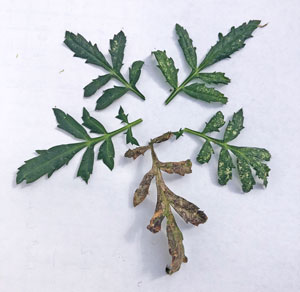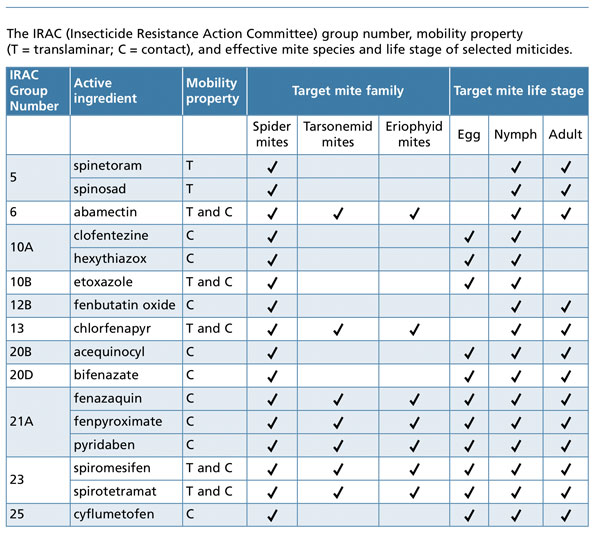4/1/2023
Put Mites in the Rearview Mirror
JC Chong

For those of us making a living producing or maintaining plants, few can claim the honor of never having to manage mites in our career. Selecting the most suitable or effective miticides is paramount to the success of a mite management program. But if your miticide selection process starts with chanting, “Mirror, mirror on the wall, what is the most effective of them all?” well, I don’t think you’ll have much success.
Figure 1. Stippling on leaves caused by spider mite feeding can progress from a few silvery dots to bleaching or bronzing very quickly.
Let me be the mirror on the wall today and tell you five important factors in deciding which miticide (or acaricide, if you prefer) to choose and use. More than 25 active ingredients with varying target spectrums are available in the United States. You will find one or several that fit your needs.
Mite species
The first question to ask is, “What is the species of the mites?” Not all mites are the same and not all miticides are created to kill all mite species. Correct identification of mite species, or at least the family, is important in selecting the correct miticides to use.
There are five major families of mites plaguing ornamental plants—spider mites (Tetranychidae), tarsonemid or thread-footed mites (Tarsonemidae), eriophyid mites (Eriophyidae), flat mites (Tenupalpidae) and bulb mites (Acaridae).
Some miticides have efficacy against many mite families, but others have a narrower target spectrum. The pest spectrum listed on the miticide labels generally reflects this difference in efficacy. Most miticides are registered against spider mites, which are the most commonly encountered family on ornamental plants.
For example, bifenazate (trade names are Floramite, Engulf and others), cyflumetofen (Sultan) and hexythiazox (Hexygon) are only registered for spider mites. Obviously, these products aren’t suitable if you have a broad mite or eriophyid mite infestation. In this case, you should reach for other products, like abamectin (Avid, Minx and other trade names), chlorfenapyr (Pylon), fenpyroximate (Akari) and spiromesifen (Savate), or combination products, such as abamectin + bifenazate (Sirocco). These products are registered for spider mites, tarsonemid mites and eriophyid mites.
I subscribe to the principle of using only miticides for mite management. Some products are both insecticides and miticides, like chlorfenapyr (Pylon), spinosad (Conserve), pyridaben (Sanmite) and spirotetramat (Kontos). Carbamates, organophosphates and pyrethroids are also registered for general mite management.
Despite their lower cost and broad-spectrum activities, I don’t typically recommend using carbamates, organophosphates and pyrethroids for mite management because some of these products are only mediocre in efficacy, have long restricted-entry interval (REI) or are rather harmful to biological control. The use of products against both mites and insects should be carefully considered in the light of insecticide resistance management (more on this later).
Mite life stage
Some miticides are more effective against specific life stages. Clofentezine (Notavo), hexythiazox (Hexygon) and etoxazole (TetraSan, Beethoven) are mite growth regulators that have efficacy only against eggs and nymphs. Other products, such as acequinocyl (Shuttle), pyridaben (Sanmite) and cyflumetofen (Sultan), have activity against the eggs, nymphs and adults.
Miticide application should start as soon as infestation is detected. Stippling on leaves caused by spider mite feeding can progress from a few silvery dots to bleaching or bronzing very quickly (Figure 1). The miticide selected for the first application should be one with good efficacy against the predominant life stage at the time of the application. If the population consists mainly of eggs and nymphs, as is typically the case during propagation and early in the crop cycle, the use of a mite growth regulator is reasonable. However, as the population continues to grow and adults begin to appear and lay more eggs, a miticide with activity only against eggs or nymphs and adults is no longer a good choice. Instead, miticides with efficacy against all life stages should be chosen.
You may argue that we only need to use miticides with efficacy against all life stages. That way, we don’t even have to scout or guess what the predominant life stage may be. Yes, you could certainly do that, but I’d still consider incorporating mite growth regulators in my management programs so that I can build a rotation program and have more options that are compatible with my biological controls.
Contact vs. translaminar miticides
Miticides also have different modes of exposures. Contact miticides are those that kill when the spray solution makes direct contact with the mites or when the mites are in contact with the residue on leaf surfaces. Some examples of contact miticides are acequinocyl (Shuttle), fenazaquin (Magus) and spiromesifen (Savate). It’s crucial to achieve thorough coverage of all surfaces when using contact miticides. Mites may survive on any surface that isn’t sprayed or has no residue deposited.
Some miticides have translaminar activities, meaning that the active ingredients will penetrate through the leaf surfaces into the cells. Miticides that have translaminar activity also have contact activity. Mites are killed when they’re in contact with the spray solution or residue, or when they ingest plant cell contents that are laced with the miticides. Examples of translaminar miticides are abamectin (Avid, Minx, etc.) and chlorfenapyr (Pylon). Although translaminar miticides are more forgiving with spray coverage, I still recommend thorough spray coverage when using translaminar miticides to achieve the best efficacy.
A perennial question I receive whenever I talk about miticides is, “Is there a systemic miticide that I can drench?” Spirotetramat (Kontos) is the only systemic insecticide that also has miticidal activity. (My team is currently working to find out if drenching with Kontos can provide systemic control of spider mite populations. I’ll update you when we have more results.)
Compatibility with biological control
Miticides and insecticides are developed to kill mites and insects, so it shouldn’t come as a surprise that some of them will also kill the beneficial insects and mites we use as biological control agents. Miticides range from not compatible (such as abamectin and chlorfenapyr) to compatible with some biological control agents (such as fenpyroximate and spiromesifen) to compatible with most biological control agents (such as clofentezine and cyflumetofen).
 It's important to know that compatibility is specific to individual species or groups of biological control agents and the time from application. A miticide that has no impact on the survival and foraging behavior of parasitic wasps may be highly toxic to predatory mites and vice versa. Also, a miticide may be highly toxic to a biological control agent when it’s in direct contact with the biological control agent, but becomes completely benign after the spray solution has dried. Information on the immediate and residual toxicity of a miticide (or insecticide) is crucial to deciding if it’s compatible with a biological control agent that’s being used or will be used, and when the biological control agents can be introduced or reintroduced. Your biological control agent suppliers are the best source for compatibility information.
It's important to know that compatibility is specific to individual species or groups of biological control agents and the time from application. A miticide that has no impact on the survival and foraging behavior of parasitic wasps may be highly toxic to predatory mites and vice versa. Also, a miticide may be highly toxic to a biological control agent when it’s in direct contact with the biological control agent, but becomes completely benign after the spray solution has dried. Information on the immediate and residual toxicity of a miticide (or insecticide) is crucial to deciding if it’s compatible with a biological control agent that’s being used or will be used, and when the biological control agents can be introduced or reintroduced. Your biological control agent suppliers are the best source for compatibility information.
Miticide resistance management
Mites, particularly the twospotted spider mite, are notorious for their ability to develop resistance to pesticides. Repeated miticide applications are often needed because mite populations grow rapidly. The risk of miticide resistance development increases with the frequency of applications.
We need to reduce the frequency of application to reduce the risk of miticide resistance development. This should start by considering carefully if an application is actually needed; preventive spray is a very wasteful idea. We can also become less reliant on miticides through the integration of biological and cultural control options in our management program.
When application is needed, we need to make every application highly effective by using the right dose and a sufficient spray volume, and achieving excellent spray coverage. Also important is to develop a miticide rotation program where each subsequent application uses a product of a different mode of action. An example of a rotation program is chlorfenapyr (Pylon; IRAC Group 13) followed by bifenazate (Floramite; 20D), fenpyroximate (Akari; 21A) and horticultural oil (unclassified). Products available in the United States encompass 12 modes of action, so there are multiple options to build a rotation program.
I often recommend four or five modes of action in each miticide rotation program. It’s helpful if a product with a general physical mode of action that mites cannot develop resistance to, such as horticultural oil or a biopesticide, can be incorporated into the rotation.
The management of other pests should also be a consideration when developing a rotation program. It’s rare that we only have to deal with one pest at a time. When a biological control program is in place against another pest, such as thrips or whiteflies, we need to select a miticide carefully so that we’re not negatively impacting the success of the biological control program. Insecticides used to control another pest population shouldn’t be included in the rotation for miticide program. GT
JC Chong is a Professor and Extension Specialist in Turf and Ornamental Crop Entomology at Clemson University, and editor of the PestTalks e-newsletter.